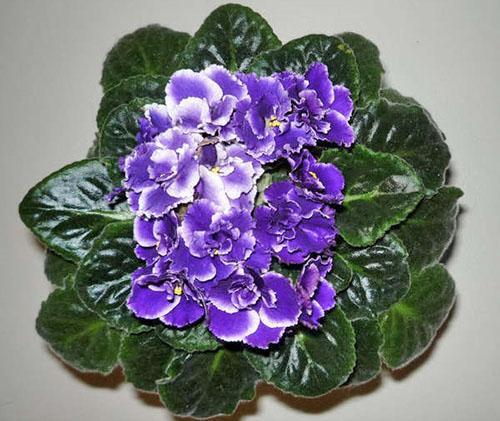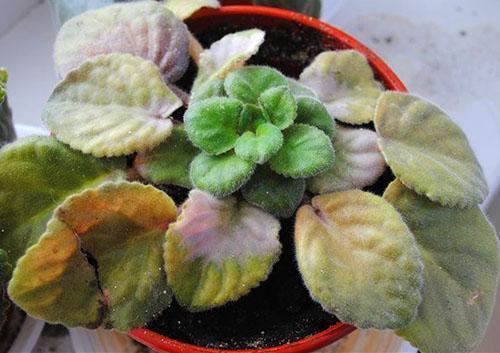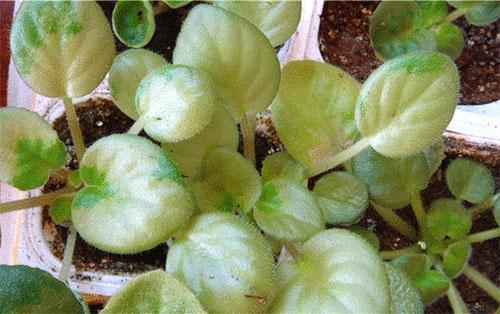How to help a violet if its leaves turn yellow
 Violets are a welcome guest on the windowsill, but to get a healthy plant, you need to master proper care. The first sign of trouble is usually a change in the appearance of the leaves. They, as indicators, make the grower wonder why the leaves of the violet turn yellow or stand upright.
Violets are a welcome guest on the windowsill, but to get a healthy plant, you need to master proper care. The first sign of trouble is usually a change in the appearance of the leaves. They, as indicators, make the grower wonder why the leaves of the violet turn yellow or stand upright.
Signs of plant diseases

The correct position of the leaves is horizontal. At the same time, the leaves do not rise and create a beautiful rosette, in the center of which there is a cap of flowers. On non-flowering Saintpaulia, the leaves are also horizontal.
Physiological changes and their signs
 The reasons for the yellowness of violet leaves:
The reasons for the yellowness of violet leaves:
- wrong placement;
- improper watering and feeding;
- the requirements for the substrate are not met;
- natural dying off of the lower leaves.
The first cause of all troubles can be the acquisition of a plant or cutting with ready-made problems. Therefore, the rooting leaf should be taken from a healthy plant without the slightest flaw and not from the lower tier of the outlet. The acquired plant must be quarantined for two weeks. This means that the plant is not included in the collection, kept separately and monitored for its condition. Diseases or insect pests during this time will be detected, and the entire collection will avoid contamination.
Yellowing of the leaves on the lower tier may mean that the violet is aged and has not been transplanted for a long time. Nourishment is scarce and it is distributed for flowers and young leaves. The reason why violet leaves turn yellow may be a lack of potassium and nitrogen... The same result is possible if the earth has lost its acidity, the elements in an alkaline medium do not pass into a soluble form. The best way out to remedy the situation may be to transplant a flower with a replacement of the ground or water it with slightly acidic water.
However, the cause may be discoloration of leaves in bright light, and not only sunlight. Violets on shelves under artificial lighting are also harmful to excessive lighting. There is a special film that can be glued to window glass or covered with plants using available methods. Violets with dark leaves are more resistant to excessive light.
The leaf blade can turn yellow from touching cold glass in winter, when watered with cold water, or abundantly. Saintpaulias love moist air, but this is achieved by placing a container of water or moist moss nearby. Can violets be sprayed? No, this will not increase the moisture, but it will ruin the Saintpaulia's appearance. The leaves do not like such moisture. Caring for them is washing with soapy water under the shower and drying them in the bathroom once a quarter. The flower with water droplets will become a focal point for the sun's rays, and the leaf will burn, it will be an unsightly brown spot.
 If the plant is standing in a draft, then this can cause the appearance of pale or bronzing leaves. Both low and high temperatures have negative consequences for the plant.At temperatures above 25 degrees, the flower plate becomes discolored.
If the plant is standing in a draft, then this can cause the appearance of pale or bronzing leaves. Both low and high temperatures have negative consequences for the plant.At temperatures above 25 degrees, the flower plate becomes discolored.
Yellow cut leaves can be used for grafting. If the corolla is cut at the bottom and the trunk is bare, then you should wrap it in moss and moisten it. As a result, roots will appear. The plant deepens and receives additional nutrition.
Why do violets have leaves rising up
 If the green leaves stretch up, there may be several reasons. One of them is insufficient one-way lighting. In order for the violet to form the correct rosette of leaves, they must all receive uniform illumination. Therefore, the pots need to be turned at a small angle after a certain time, changing the illumination of the leaves.
If the green leaves stretch up, there may be several reasons. One of them is insufficient one-way lighting. In order for the violet to form the correct rosette of leaves, they must all receive uniform illumination. Therefore, the pots need to be turned at a small angle after a certain time, changing the illumination of the leaves.
Another reason why the leaves of a violet rise upward may be dry superheated air, from which the leaves tend to protect the core of the flower. The leaves are outraged when changing places, because they are couch potatoes. If the edges of the plate are also bent, then the plant requires nitrogen feeding, but within the normal range. In cramped conditions, the leaf blade can rise in the struggle for a place in the sun.
Infectious diseases of violets
 Infectious diseases include those that are introduced into a weakened plant. Therefore, the cause of the disease is always improper care. In order to protect Saintpaulia from diseases, you should first of all not bring the infection with new plants. Quarantine serves as a warning. The plant can be weakened by:
Infectious diseases include those that are introduced into a weakened plant. Therefore, the cause of the disease is always improper care. In order to protect Saintpaulia from diseases, you should first of all not bring the infection with new plants. Quarantine serves as a warning. The plant can be weakened by:
- non-compliance with the thermal regime;
- improper watering of plants:
- drafts, cold damp corner where the plant was placed.
 In such conditions, rot appears on the stems or roots of the violet, zones where late blight can penetrate. This is one of the formidable infectious diseases of Saintpaulia when temperature and humidity are not observed. The causative agent of the disease is transmitted by soil. Therefore, it is important to disinfect all purchased and homemade soil.
In such conditions, rot appears on the stems or roots of the violet, zones where late blight can penetrate. This is one of the formidable infectious diseases of Saintpaulia when temperature and humidity are not observed. The causative agent of the disease is transmitted by soil. Therefore, it is important to disinfect all purchased and homemade soil.
Another disease that can destroy all violets in a short time is called powdery mildew, which begins as a harmless dusty white bloom, ends with the death of the plant. Powdery mildew on violets requires quick treatment. It is impossible to take layering from such a copy.
 For treatment in the early stages, you can use special drugs such as "Topaz" or "Saprol". Only when you notice a powdery coating, cover the plant with sulfur powder, seal it with a bag and create a temperature of 25 0to kill the mycelium. Can be sprayed using a slurry of baking soda and laundry soap. If powdery mildew is started on the violet, destroy the plant, and carry out preventive treatment for the remaining inhabitants of the windowsill.
For treatment in the early stages, you can use special drugs such as "Topaz" or "Saprol". Only when you notice a powdery coating, cover the plant with sulfur powder, seal it with a bag and create a temperature of 25 0to kill the mycelium. Can be sprayed using a slurry of baking soda and laundry soap. If powdery mildew is started on the violet, destroy the plant, and carry out preventive treatment for the remaining inhabitants of the windowsill.
 The difference between infectious rot is that it spreads to all plants in cramped conditions. Non-communicable diseases due to improper care can kill one plant.
The difference between infectious rot is that it spreads to all plants in cramped conditions. Non-communicable diseases due to improper care can kill one plant.
What happened to the violet? I ordered a rooted stepson in the online store. The leaves are extended upward. Immediately transplanted into the ground for violets. After a few days, spots appeared on the leaves.